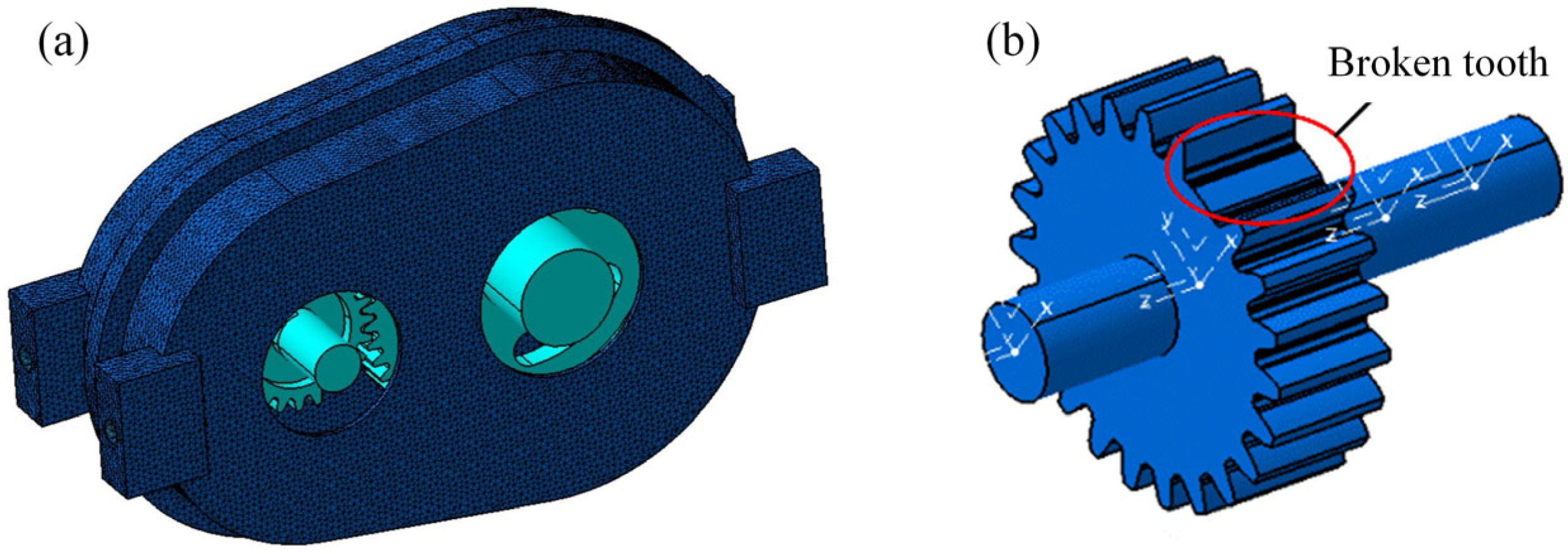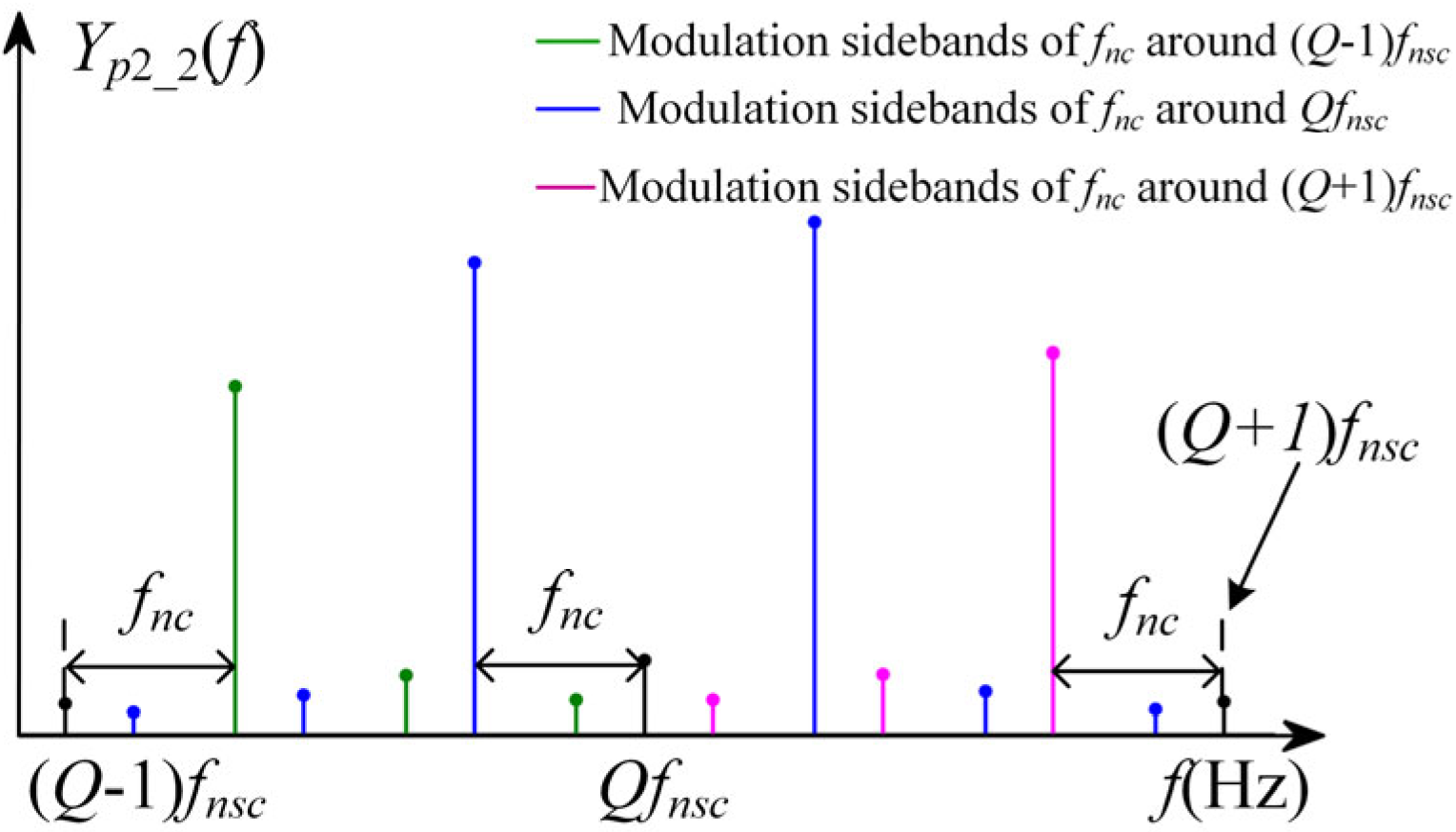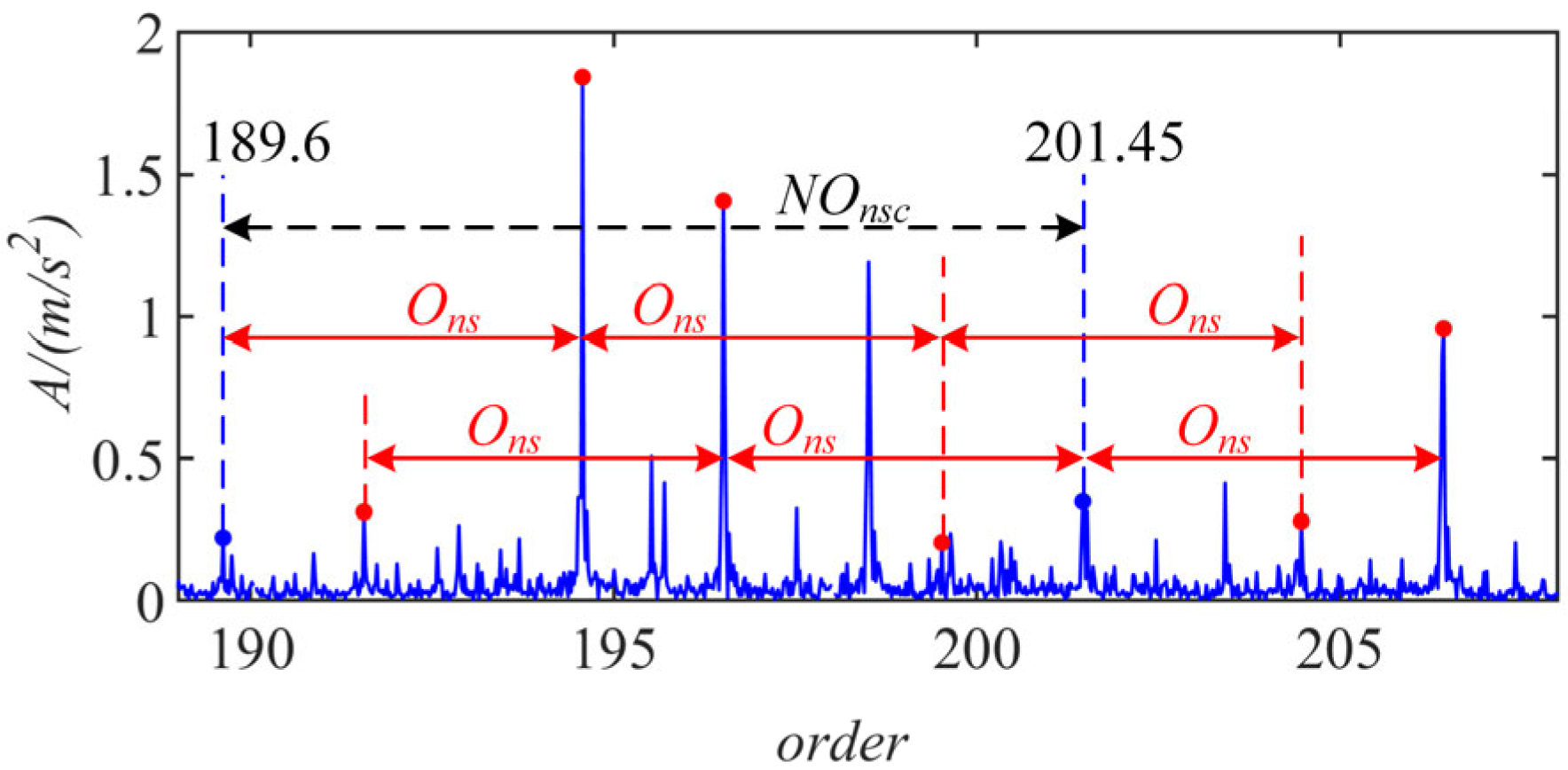Improved Vibration Signal Models of Localized Faults of Sun Gears to Predict Modulation
Abstract
:1. Introduction
2. Factors Affecting Vibration Signals
2.1. Structural Features of Planetary Gear Sets
2.2. Influence of Speed Fluctuation on Considered Factors
- (1)
- Transfer path function under the effect of speed fluctuations
- (2)
- Projection function under the effect of speed fluctuations
- (3)
- Meshing force under the effect of speed fluctuations
3. Vibration AM–FM Sidebands of Localized Faults of Sun Gears
3.1. Vibration AM–FM Sideband Generated by Single Planet Gear
- (1)
- Vibration AM–FM sidebands of path 1
- (2)
- Vibration AM–FM sidebands of path 2
- (3)
- Vibration AM–FM sidebands of path 3
3.2. Total Vibration Signal of the Meshing of Multiple Planet Gears
4. Experimental Analyses
5. Conclusions
Author Contributions
Funding
Data Availability Statement
Conflicts of Interest
Appendix A
References
- Chen, Z.; Liao, Y.; Li, J.; Huang, R.; Xu, L.; Jin, G.; Li, W. Multi-source Weighted Deep Transfer Network for Open-set Fault Diagnosis of Rotary Machinery. IEEE Trans. Cybern. 2022, 53, 1982–1993. [Google Scholar] [CrossRef] [PubMed]
- Chen, M.; Shao, H.; Dou, H.; Li, W.; Liu, B. Data augmentation and intelligent fault diagnosis of planetary gearbox using ILoFGAN under extremely limited samples. IEEE Trans. Reliab. 2022. [Google Scholar] [CrossRef]
- Li, Q.; Liang, S.Y. Weak fault detection for gearboxes using majorization–minimization and asymmetric convex penalty regularization. Symmetry 2018, 10, 243. [Google Scholar] [CrossRef]
- Cui, L.; Liu, T.; Huang, J.; Wang, H. Improvement on meshing stiffness algorithms of gear with peeling. Symmetry 2019, 11, 609. [Google Scholar] [CrossRef]
- Mohammed, S.A.; Ghazaly, N.M.; Abdo, J. Fault diagnosis of crack on gearbox using vibration-based approaches. Symmetry 2022, 14, 417. [Google Scholar] [CrossRef]
- Wang, T.; Han, Q.; Chu, F.; Feng, Z. Vibration based condition monitoring and fault diagnosis of wind turbine planetary gearbox: A review. Mech. Syst. Signal Process. 2019, 126, 662–685. [Google Scholar] [CrossRef]
- Zghal, B.; Graja, O.; Dziedziech, K.; Chaari, F.; Jablonski, A.; Barszcz, T.; Haddar, M. A new modeling of planetary gear set to predict modulation phenomenon. Mech. Syst. Signal Process. 2019, 127, 234–261. [Google Scholar] [CrossRef]
- Feki, N.; Karray, M.; Khabou, M.T.; Chaari, F.; Haddar, M. Frequency analysis of a two-stage planetary gearbox using two different methodologies. Comptes Rendus Méc. 2017, 345, 832–843. [Google Scholar] [CrossRef]
- McFadden, P.D.; Smith, J.D. An explanation for the asymmetry of the modulation sidebands about the tooth meshing frequency in epicyclic gear vibration. Proc. Inst. Mech. Eng. Part C J. Mech. Eng. Sci. 1985, 199, 65–70. [Google Scholar] [CrossRef]
- Inalpolat, M.; Kahraman, A. A theoretical and experimental investigation of modulation sidebands of planetary gear sets. J. Sound Vib. 2009, 323, 677–696. [Google Scholar] [CrossRef]
- Li, Y.; Ding, K.; He, G.; Yang, X. Vibration modulation sidebands mechanisms of equally-spaced planetary gear train with a floating sun gear. Mech. Syst. Signal Process. 2019, 129, 70–90. [Google Scholar] [CrossRef]
- He, G.; Ding, K.; Wu, X.; Yang, X. Dynamics modeling and vibration modulation signal analysis of wind turbine planetary gearbox with a floating sun gear. Renew. Energy 2019, 139, 718–729. [Google Scholar] [CrossRef]
- He, G.; Ding, K.; Li, W.; Li, Y. Frequency response model and mechanism for wind turbine planetary gear train vibration analysis. IET Renew. Power Gener. 2016, 11, 425–432. [Google Scholar] [CrossRef]
- Luo, Y.; Cui, L.; Ma, J. Effect of bolt constraint of ring gear on the vibration response of the planetary gearbox. Mech. Mach. Theory 2021, 159, 104260. [Google Scholar] [CrossRef]
- Yang, X.; Wang, L.; Ding, K.; Ding, X. Vibration AM-FM sidebands mechanism of planetary gearbox with tooth root cracked planet gear. Eng. Fail. Anal. 2022, 137, 106353. [Google Scholar] [CrossRef]
- Inalpolat, M.; Kahraman, A. A dynamic model to predict modulation sidebands of a planetary gear set having manufacturing errors. J. Sound Vib. 2017, 329, 371–393. [Google Scholar] [CrossRef]
- Liang, X.; Zuo, M.J.; Hoseini, M.R. Vibration signal modeling of a planetary gear set for tooth crack detection. Eng. Fail. Anal. 2015, 48, 185–200. [Google Scholar] [CrossRef]
- Lei, Y.; Liu, Z.; Lin, J.; Lu, F. Phenomenological models of vibration signals for condition monitoring and fault diagnosis of epicyclic gearboxes. J. Sound Vib. 2016, 369, 266–281. [Google Scholar] [CrossRef]
- Luo, Y.; Cui, L.; Zhang, J.; Ma, J. Vibration mechanism and improved phenomenological model of planetary gearbox with broken sun gear fault. Measurement 2021, 178, 109356. [Google Scholar] [CrossRef]
- Han, H.; Zhao, Z.; Tian, H.; Ma, H.; Yang, Y.; Li, X. Fault feature analysis of planetary gear set influenced by cracked gear tooth and pass effect of the planet gears. Eng. Fail. Anal. 2021, 121, 105162. [Google Scholar] [CrossRef]
- Yu, X.; Feng, Z.; Liang, M. Analytical vibration signal model and signature analysis in resonance region for planetary gearbox fault diagnosis. J. Sound Vib. 2021, 498, 115962. [Google Scholar] [CrossRef]
- Xu, L.; Ding, K.; He, G.; Li, Y.; Chen, Z. Resonance modulation vibration mechanism of equally-spaced planetary gearbox with a localized fault on sun gear. Mech. Syst. Signal Process. 2022, 166, 108450. [Google Scholar] [CrossRef]
- Yang, X.; Ding, K.; He, G.; Du, C.; Yu, W. Improved vibration AM-FM sideband phenomenon models of planetary gear set with distributed faults and fault-induced speed fluctuation. Mech. Mach. Theory 2023, 179, 105093. [Google Scholar] [CrossRef]
- Bachar, L.; Dadon, I.; Klein, R. The effects of the operating conditions and tooth fault on gear vibration signature. Mech. Syst. Signal Process. 2021, 154, 107508. [Google Scholar] [CrossRef]
- Randall, R.B. A new method of modeling gear faults. J. Mech. Des. 1982, 104, 259–267. [Google Scholar] [CrossRef]
- Sika, G.; Velex, P. Instability analysis in oscillators with velocity-modulated time-varying stiffness—Applications to gears submitted to engine speed fluctuations. J. Sound Vib. 2008, 318, 166–175. [Google Scholar] [CrossRef]
- Yang, X.; Ding, K.; He, G. Phenomenon-model-based AM-FM vibration mechanism of faulty spur gear. Mech. Syst. Signal Process. 2019, 134, 106366. [Google Scholar] [CrossRef]














| Structural Parameters | Feature Orders | Order | |
|---|---|---|---|
| No. teeth of sun gear | 20 | Rotational order of carrier Onc | 1 |
| No. teeth of planet gear | 28 | Fault feature order of planet gear Onpc | 2.821 |
| No. teeth of ring gear | 79 | Meshing order Oz | 79 |
| Number of planets | 3 | Fault feature order of sun gear Onsc | 3.95 |
Disclaimer/Publisher’s Note: The statements, opinions and data contained in all publications are solely those of the individual author(s) and contributor(s) and not of MDPI and/or the editor(s). MDPI and/or the editor(s) disclaim responsibility for any injury to people or property resulting from any ideas, methods, instructions or products referred to in the content. |
© 2023 by the authors. Licensee MDPI, Basel, Switzerland. This article is an open access article distributed under the terms and conditions of the Creative Commons Attribution (CC BY) license (https://creativecommons.org/licenses/by/4.0/).
Share and Cite
Yang, X.; Yang, G.; Zeng, Q.; Du, C.; Zeng, X.; Yu, F.; Chen, Z. Improved Vibration Signal Models of Localized Faults of Sun Gears to Predict Modulation. Symmetry 2023, 15, 1621. https://doi.org/10.3390/sym15091621
Yang X, Yang G, Zeng Q, Du C, Zeng X, Yu F, Chen Z. Improved Vibration Signal Models of Localized Faults of Sun Gears to Predict Modulation. Symmetry. 2023; 15(9):1621. https://doi.org/10.3390/sym15091621
Chicago/Turabian StyleYang, Xiaoqing, Gang Yang, Qiang Zeng, Canyi Du, Xiangkun Zeng, Feifei Yu, and Zhuyun Chen. 2023. "Improved Vibration Signal Models of Localized Faults of Sun Gears to Predict Modulation" Symmetry 15, no. 9: 1621. https://doi.org/10.3390/sym15091621







